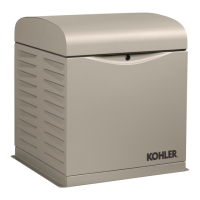
Do you have a question about the Kohler Power Systems 8RESV and is the answer not in the manual?
| Model | 8RESV |
|---|---|
| Type | Portable Generator |
| Rated Power | 8 kW |
| AC Rated Output (Watts) | 8000 W |
| AC Maximum Output (Watts) | 10000 W |
| Fuel Type | Gasoline |
| Voltage | 120/240 V |
| Frequency | 60 Hz |
| Starting Method | Electric |
| Noise Level | 72 dBA |
| Starting System | Electric |
Lists manuals and documents related to the generator set, including spec sheets, installation, and operation manuals.
Contact information for Kohler Power Systems regional offices in EMEA, Asia Pacific, China, India, Japan, and Latin America.
Overview of generator set specifications, nameplate data, and related documentation.
Details on RDC2 and DC2 controller features, requirements, and environmental specifications.
Information on the types of Kohler engines used in the generator sets.
Technical specifications for the 8RESV(L) and 10/12RESV(L) generator set engines.
Technical specifications for the generator set alternators, including electrical and physical data.
Torque values for various fasteners used in the generator set assembly.
Labeled diagrams showing generator set components and their locations for service.
A comprehensive table detailing maintenance tasks, frequency, and corresponding manual sections.
Procedures and recommendations for checking oil levels, oil changes, and engine oil type.
Procedures for inspecting, adjusting gap, and replacing spark plugs.
Procedures for servicing the replaceable paper air cleaner element for all models.
Information on the generator set's cooling system airflow and intake/exhaust locations.
Safety precautions and maintenance related to the exhaust system, including carbon monoxide hazards.
Procedure for replacing the stepper motor coupling and bushings.
Safety precautions and maintenance procedures for the generator set's fuel system.
Safety precautions and procedures for battery maintenance, including electrolyte level and specific gravity.
Steps for preparing the generator set for storage, covering lubrication, fuel, cylinder, exterior, and battery.
Introduction to the RDC2 and DC2 controllers and their functions.
Information on using PC software for controller setup, parameter changes, and firmware updates.
Overview of adjustable and non-adjustable controller parameters and how they are organized in SiteTech.
Information on obtaining and updating controller firmware versions.
Procedure for replacing a faulty controller, including required setup after installation.
Procedures for setting up the controller after installation or replacement using keypad or software.
Importance and procedures for performing voltage calibration on the controller.
Procedures for resetting the OnCue Plus password on RDC2 and DC2 controllers.
Introduction to troubleshooting procedures, required knowledge, and service personnel.
Explanation of the electronic start sequence of the generator set, detailing component energization.
Basic checks to perform first when troubleshooting, such as connections, battery, and fuel supply.
Information about the controller's USB port for service and software interaction.
Explanation of line circuit breaker, auxiliary winding circuit breaker, and controller internal protection.
Information about the enclosure thermostat and procedures to reset it.
Reference to the manual for troubleshooting the OnCue Plus Generator Management System.
Troubleshooting common fuel system issues, including gas and LPG leaks.
Table of fault messages, their descriptions, actions, and recommended checks for the RDC2 controller.
Table of status messages displayed by the controller or in SiteTech, indicating system status.
A chart listing common generator set problems, possible causes, tests, corrective actions, and references.
Specific troubleshooting steps for controller display, communication, and configuration issues.
Introduction to testing and adjusting components, and using troubleshooting in Section 4.
Explanation of how the rotating-field alternator produces AC voltage and the start sequence.
Procedures and information for testing alternator excitation and troubleshooting low/no voltage.
Procedures for testing the stator for continuity, resistance, and shorts.
Procedures for testing the rotor for continuity, resistance, and shorts.
Information on the maintenance and cleaning of slip rings.
Procedures for inspecting and replacing brushes and brush holders.
Diagram of factory wiring configurations for 120/240 Volt, 3-Wire output.
General information and safety precautions for adjusting generator output voltage.
Overview of the governor system, its operation, and initial checks.
Procedure for adjusting the generator output frequency by changing engine speed.
Tests for overspeed, overcrank, and low oil pressure shutdowns, and controller fault functions.
Information and safety precautions for the fuel system, including solenoid valve, CDI, and regulators.
Procedure for converting the fuel system between natural gas and LPG.
Location and testing procedures for the starter and run relays.
Procedures and tables for checking component continuity using an ohmmeter.
Initial steps required before disassembling the generator set, including safety and draining.
Detailed procedures for disassembling the generator set enclosure, electrical leads, and alternator.
Procedures for reassembling the generator set, including mounting plate, silencer, alternator, and enclosure.
List of available wiring diagrams and schematics with corresponding page numbers.
Dimensional drawing of the generator set, showing overall dimensions and key features (Sheet 1).
Dimensional drawing of the generator set, showing internal component locations (Sheet 2).
Dimension drawing illustrating clearance requirements for generator set installation (Sheet 3).
Dimensional drawing of the generator set, showing overall dimensions and key features (Sheet 1).
Dimensional drawing of the generator set, showing internal component locations (Sheet 2).
Dimension drawing illustrating clearance requirements for generator set installation (Sheet 3).
Schematic diagram of the generator set's electrical system, showing connections and components.
Point-to-point wiring diagram illustrating the physical routing of wires and connections.
A comprehensive list of abbreviations used throughout the manual with their meanings.
Guidelines for identifying and applying common hardware, including bolt length and washer rules.
Torque values for American Standard fasteners assembled into cast iron, steel, and aluminum.
Torque values for metric fasteners assembled into cast iron, steel, and aluminum.
Illustrations and names for various screw, bolt, and stud head styles.
Illustrations and names for various nut styles.
Illustrations and names for various washer styles.
Identification of American Standard and Metric hardness grades for hardware.
Examples of sample dimensions for American Standard and Metric hardware.
List of part numbers and dimensions for common American Standard hardware items.
List of part numbers and dimensions for common Metric hardware items.